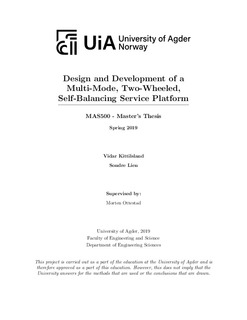| dc.description.abstract | This thesis covers the design and development of a multi-mode, two-wheeled, self-balancing serviceplatform. The purpose of such a platform is to assist people with transportation tasks in crowdedspaces like airports by consuming as little space as possible and minimizing its overall footprint.This is solved by constructing a robot that can transition between bicycle and differential driveconfigurations and keep its balance in both configurations as well as in the transition processbetween them. A two-wheeled, self-balancing robot is an inherently unstable system that can bebased on the theory of an inverted pendulum. The unstable system is stabilized using a sophisticatedstate space control approach that utilizes the mathematical models of the different dynamic systemsof the control modes to provide full state feedback.The mechanical structure is designed and built mainly from steel profiles, 3D-printed parts, andlaser cut parts to satisfy the robot’s requirements to rigidity and mechanical properties. A custommade battery pack is also designed to minimize the weight of the robot while simultaneouslyenabling the robot to run for a desired amount of time without recharging.The result is a robot that balances satisfyingly in both bicycle and differential drive configurationsand presents a proof-of-concept prototype that shows that products such as this robot are highlyfeasible. Due to time limitations and limited access to proper equipment, some theory in this thesiswas not executed in practice but is considered as potential further work on the service platform.
For video of the resulting system, please see the URL below. https://youtu.be/KidiPGkNSt0
Keywords:
Machine design, Control design, Simulation, MATLAB, Simulink, LabVIEW, SOLIDWORKS, State-space, Stabilization, Full State-feedback, Kinematics | nb_NO |

